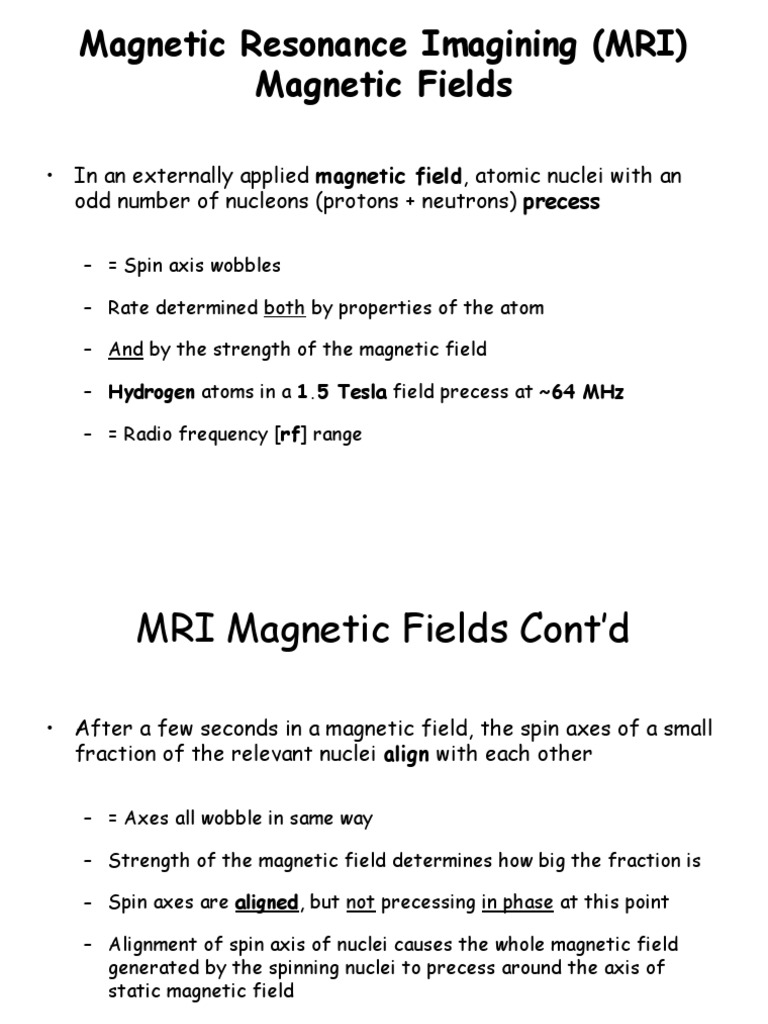The field of magnetic resonance imaging (MRI) is continually evolving, leveraging advances in technology and physics to enhance diagnostic capabilities. At the core of MRI lies the sophisticated manipulation of magnetic fields, including the often-overlooked concept of non-uniform magnetic fields. This prompts a provocative question: Why do we need non-uniform magnetic fields in MRI, and what challenges do they pose in medical imaging? The exploration of this question delves into both the theoretical framework and practical application of non-uniform magnetic fields in MRI.
To understand the necessity of non-uniform magnetic fields, one must first appreciate the fundamental principles governing MRI. Traditionally, a uniform magnetic field is utilized to polarize hydrogen nuclei within a patient’s body. This polarization serves as the bedrock for generating the MRI signals, which are subsequently transformed into detailed images. However, the limitations of uniform fields become evident when considering the spatial variability of human anatomy and the intricacies of disease presentation. This variability necessitates a re-evaluation of how magnetic fields can be employed to maximize the imaging potential across various biological structures.
Let us embark on a journey through the multifaceted advantages presented by non-uniform magnetic fields in MRI. The first significant merit is related to spatial resolution. Non-uniform magnetic fields can enhance the contrast between adjacent tissues, allowing radiologists to differentiate between structures that possess subtle differences in magnetic properties. For instance, in the case of tumor detection, the presence of even the minutest abnormalities can be discerned more effectively when non-uniformity is introduced into the magnetic landscape. This granularity in imaging capabilities surmounts the constraints associated with uniform fields, where similar tissues may blend together, obscuring critical diagnostic information.
Moreover, the application of non-uniform magnetic fields is instrumental in advancing various MRI modalities, such as functional MRI (fMRI) and diffusion tensor imaging (DTI). In fMRI, regions of the brain exhibiting heightened metabolic activity can be visualized against a backdrop of relative quiescence. The BOLD (blood-oxygen-level-dependent) contrast mechanism that underpins fMRI relies on non-uniform magnetic fields to facilitate the longitudinal relaxation times of protons in oxygenated versus deoxygenated blood. Consequently, this variance is accentuated, facilitating the identification of brain regions engaged during cognitive tasks.
However, the implementation of non-uniform magnetic fields is not without its complexities. Medical imaging practitioners face challenges associated with field inhomogeneities, primarily manifested through artifacts in the resultant images. These artifacts can lead to misinterpretations, erroneously suggesting pathological conditions where none exist. For instance, ghosting and shading effects may emerge in regions where the magnetic field is less uniform. MRI technologists and radiologists must develop a keen understanding of these artifacts to mitigate their impact, necessitating a combination of technical acumen and interpretative skill. Hence, while non-uniform fields enhance imaging capabilities, they concurrently introduce a layer of complexity that necessitates diligent attention to detail and quality control.
In addition to imaging artifacts, there lies an intriguing interplay between non-uniform magnetic fields and patient comfort. Traditional MRI machines utilize a strong, uniform magnetic field to ensure signal homogeneity. However, the introduction of non-uniform fields can affect the force exerted on different tissues and their magnetic susceptibilities, potentially resulting in discomfort or pain due to mechanical forces. This discomfort can lead to motion artifacts as patients may inadvertently move during the imaging process, further complicating the diagnostic interpretation of scans. Consequently, it is essential for practitioners to find an optimal balance where imaging efficacy is not compromised while ensuring patient well-being during the procedure.
In light of these considerations, research efforts are increasingly focused on developing techniques to refine the non-uniform magnetic fields utilized in clinical practice. The advent of advanced gradient coils and radiofrequency (RF) pulse sequences has expanded the horizons of MRI capabilities, permitting more robust and nuanced imaging. These innovations seek to ensure that non-uniform magnetic fields do not detract from the quality of images produced but rather enhance them to the greatest extent possible. Consequently, the evolution of these technologies symbolizes not merely an advance in imaging techniques, but a philosophical shift towards embracing the complexity of biological systems through nuanced diagnostic measures.
As the field of MRI continues to evolve, it stands at the precipice of numerous technological breakthroughs, with non-uniform magnetic fields playing a pivotal role. The ability to navigate the inherent challenges posed by field non-uniformities will determine how effectively these advances can be integrated into routine clinical practices. Thus, the ultimate inquiry may not simply center around the need for non-uniform magnetic fields, but rather how the medical community can harness their potential while maintaining the integrity and clarity of the diagnostic images necessary to inform critical healthcare decisions.
In conclusion, the need for non-uniform magnetic fields in MRI arises from the complexities of human anatomy and the continuous quest for improved diagnostic accuracy. While these fields possess the power to amplify imaging resolution and contrast, they also usher in challenges that require sophisticated understanding and management. As the field progresses, it is incumbent upon researchers and practitioners alike to remain at the forefront of innovation, ensuring that the potential of non-uniform magnetic fields is fully realized in the pursuit of exceptional patient care.












